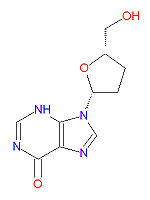Didanosine
|
| |||||||
| didanosine | |||||||
| |||||||
| Uses: | HIV | ||||||
| Properties: | Reverse transcriptase inhibitor | ||||||
| Hazards: | see drug interactions | ||||||
| |||||||
Didanosine (DDI), or dideoxyinosine, is a potent HIV-1 reverse transcriptase inhibitor that also acts as a viral DNA chain terminator. Treatment with DDI after long-term AZT treatment has been beneficial. Didanosine is unusual among nucleoside analogs because it does not contain a regular base or regular sugar, but instead contains hypoxanthine attached to a dideoxy sugar. The absence of a 3'-hydroxy group on the sugar prevents the formation of phosphodiester linkages which are needed for the completion of nucleic acid chains. DDI is metabolized to dideoxyadenosine triphosphate (ddATP), its putative active metabolite that competes with dATP. It is often taken with antacids because its stability is low under acidic conditions. It is sold under the brand names Videx and Videx EC. Possible toxic side effects including diarrhea, liver dysfunction, hyperuricemia, pancreatitis and peripheral neuropathy.
Chemistry
Its IUPAC chemical name is 9-[(2R,5S)-5-(hydroxymethyl)oxolan-2-yl]-3H-purin-6-one and its chemical formula is C10H12N4O3 (MW 236.2273).
Drug Interactions
The effects and toxicity of didanosine is increased when taken with ganciclovir, tenofovir or valganciclovir. DDI levels may be reduced when taken with tipranavir. The risk of peripheral neuropathy toxicity is additive for the DDI/zalcitabine combination.
External Links
- Didanosine - FDA approved drug information (drug label) from DailyMed (U.S. National Library of Medicine).
- Template:MedMaster
- Template:DrugBank
